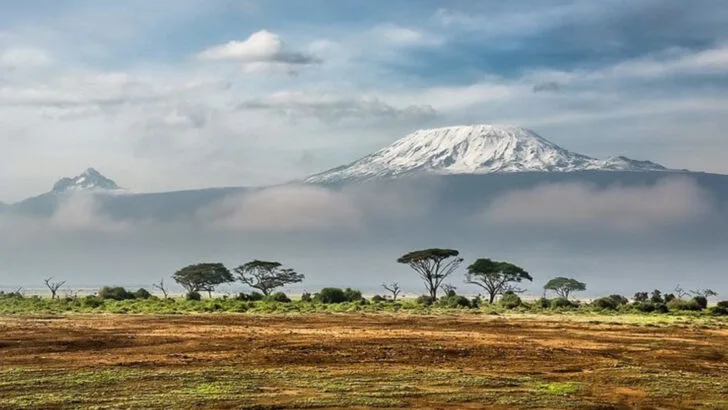Beyond America’s borders, the world holds awe-inspiring landscapes that remind us how small we are against the artistry of nature. From soaring cliffs to glowing caves, fiery volcanoes to icy fjords, these natural wonders prove that the Earth is still our greatest masterpiece.
Whether carved by wind, shaped by water, or born of fire, these global treasures invite us to wander, wonder, and witness the sheer power and beauty of the planet we call home.
Great Barrier Reef
A mesmerizing underwater realm teems with life beneath the turquoise waves. Australia’s Great Barrier Reef is home to thousands of marine species, offering a vivid glimpse into aquatic diversity. This natural wonder stretches over 1,400 miles, making it visible from space.
Snorkelers and divers flock to its vibrant coral gardens, eager to witness the spectacle of colorful fish and intricate coral formations. The reef’s importance to marine ecology is profound, making conservation efforts crucial. With its stunning beauty and ecological significance, it’s a must-visit for ocean enthusiasts.
Mount Everest
Nestled between Nepal and Tibet, Mount Everest towers as Earth’s highest peak. Its majestic presence has beckoned adventurers for decades. Climbing this mountain is a formidable challenge, testing even the most seasoned explorers.
The summit, draped in snow and ice, offers an unparalleled view of the Himalayas. Despite its allure, the journey is fraught with dangers, from harsh weather to treacherous paths. Yet, reaching the top remains a pinnacle achievement for mountaineers worldwide.
Victoria Falls
The thunderous roar of cascading water at Victoria Falls leaves visitors awestruck. Straddling the border of Zambia and Zimbabwe, it’s one of the largest waterfalls on Earth.
Known locally as ‘The Smoke that Thunders,’ its mist creates vibrant rainbows that enchant observers. The falls are a vital part of the Zambezi River ecosystem, supporting diverse wildlife. Adventurers can explore the surrounding rainforest or take a thrilling swim at the Devil’s Pool.
Aurora Borealis
Few spectacles match the ethereal beauty of the Aurora Borealis. Dancing across the northern skies, these luminous displays captivate onlookers in Scandinavia, Iceland, and Canada.
Charged particles from the sun collide with Earth’s atmosphere, creating this mesmerizing light show. Each aurora is unique, with colors ranging from vibrant green to deep purple. Stargazers bundle up to witness this celestial ballet, a truly unforgettable experience.
Amazon Rainforest
A sprawling green sea, the Amazon Rainforest is the planet’s largest tropical rainforest. It covers much of South America, housing immense biodiversity.
Home to countless species, including jaguars and toucans, the forest is a treasure trove of life. Its vital role in carbon absorption underscores its global importance. However, deforestation threatens this ecological marvel, making preservation efforts crucial.
Galápagos Islands
Charles Darwin’s muse, the Galápagos Islands, offer unparalleled wildlife encounters. Located off Ecuador’s coast, these islands boast species found nowhere else.
Giant tortoises and marine iguanas roam the volcanic terrains, illustrating evolution’s wonders. The islands’ unique ecosystems continue to intrigue scientists and nature lovers alike. Protecting this biodiversity hotspot remains a pressing priority.
Sahara Desert
Stark and expansive, the Sahara Desert spans North Africa, offering a striking landscape of dunes and oases. It’s the world’s largest hot desert, exuding a harsh yet captivating beauty.
Nomadic tribes have traversed its shifting sands for centuries, guided by the stars. Despite the arid environment, life persists, with flora and fauna adapted to the extreme conditions. The Sahara’s allure lies in its vast, unspoiled wilderness.
Milford Sound
A serene fjord enveloped by towering cliffs and cascading waterfalls, Milford Sound sits on New Zealand’s South Island. Its tranquility is punctuated by the call of native birds.
Visitors often explore by boat, marveling at the sheer rock faces and marine life. The area’s pristine beauty is a hallmark of New Zealand’s natural offerings, drawing travelers worldwide. Rain adds to its mystique, cloaking the fjord in mist.
Iguazu Falls
A breathtaking spectacle of power and scale, Iguazu Falls straddles the border of Argentina and Brazil. The system of cascades stretches nearly two miles, creating a thundering symphony.
Surrounded by subtropical rainforest, the falls nurture a vibrant ecosystem. Visitors can explore walkways offering close-up views of the torrents. Its roaring beauty makes it a highlight of South American natural wonders.
Mount Kilimanjaro
An iconic silhouette against the African sky, Mount Kilimanjaro rises majestically in Tanzania. As Africa’s highest peak, it offers a diverse climbing experience through varied climate zones.
Trekkers ascend from tropical rainforest to alpine desert, culminating in a snowy summit. Its beauty attracts adventurers seeking a unique challenge. The mountain’s glaciers provide a stunning contrast to the surrounding savannah.
Ha Long Bay
Emerald waters and towering limestone karsts define Vietnam’s Ha Long Bay. This UNESCO World Heritage Site enchants with its serene beauty.
Traditional junk boats navigate the bay, offering glimpses of hidden caves and floating villages. Each karst formation presents a unique silhouette against the horizon. Ha Long Bay’s tranquil allure and cultural richness captivate visitors.
Pamukkale
Turkey’s Pamukkale is renowned for its surreal landscape of white calcite terraces. These natural formations are created by mineral-rich thermal waters cascading down the hillside.
Visitors bathe in the warm, turquoise pools, touted for their healing properties. The site also includes ancient ruins, adding a historical dimension. Pamukkale’s ethereal beauty and archaeological significance make it a fascinating destination.
Giant’s Causeway
Northern Ireland’s Giant’s Causeway offers a geological marvel of interlocking basalt columns. Legend speaks of giants who once walked here, but the formation is volcanic in origin.
These unique hexagonal stones create a dramatic coastline, drawing curious visitors. The site’s folklore adds an enchanting layer to its natural beauty. Exploring the columns and learning their history is an enthralling experience.
Cliffs of Moher
Ireland’s Cliffs of Moher stretch for miles along the Atlantic, offering breathtaking views and dramatic drop-offs. These iconic cliffs are a symbol of the wild Irish coast.
Birdwatchers delight in spotting puffins and other seabirds nesting on the rocky edges. The cliffs’ rugged beauty and panoramic vistas make them a must-see for nature enthusiasts. Walking along the edge is an exhilarating adventure.
Parícutin Volcano
Erupting unexpectedly from a farmer’s field in 1943, Parícutin is a geological wonder in Mexico. Its sudden appearance and growth captured the world’s attention.
Though now dormant, the volcano’s legacy endures in the surrounding lava fields. Hiking to the summit offers views of this stark landscape and the lush forest beyond. Stories of its birth and impact remain vivid in local lore.
Jeju Island Lava Tubes
South Korea’s Jeju Island hides an underground treasure in its lava tubes. These subterranean passages, formed by flowing lava, intrigue with their mysterious allure.
Visitors wander through the eerie tunnels, marveling at stalactites and unique rock formations. The tubes are part of Jeju’s UNESCO status, highlighting their geological importance. Exploring these dark, cavernous spaces is a unique adventure.
Zhangjiajie National Forest Park
Inspiration for fantastical landscapes, Zhangjiajie’s sandstone pillars pierce the sky in China. These natural formations create an otherworldly scene reminiscent of a mystical realm.
The park’s beauty is accentuated by its misty atmosphere, enveloping the pillars in mystery. Visitors traverse glass walkways, gaining unparalleled views of the formations. Its dreamlike environment continues to inspire artists and filmmakers.
Mount Fuji
Japan’s iconic Mount Fuji is more than a mountain; it’s a cultural symbol. Its symmetrical peak is often depicted in art and literature.
Hiking to its summit offers a spiritual journey, drawing pilgrims and adventurers. In spring, cherry blossoms frame Fuji’s snow-capped beauty, offering a picturesque scene. The mountain’s cultural and natural significance is deeply interwoven into Japanese identity.
Salar de Uyuni
Bolivia’s Salar de Uyuni, the world’s largest salt flat, transforms into a giant mirror during the rainy season. This natural wonder creates surreal reflections that stretch to the horizon.
Visitors capture stunning photographs as they walk across this expansive, white expanse. The flat’s beauty lies in its simplicity, offering a stark contrast to the surrounding Andean peaks. Exploration by 4×4 is a popular way to experience its vastness.
Banff National Park
Nestled in Canada’s Rockies, Banff National Park is a gem of natural beauty. Its turquoise glacial lakes and snow-draped peaks offer a breathtaking panorama.
Outdoor enthusiasts revel in activities like hiking, skiing, and wildlife spotting. The park’s pristine landscapes provide habitat for diverse species, from bears to elk. Banff’s stunning scenery and outdoor opportunities make it a cherished destination.

